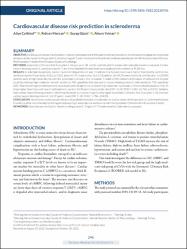| dc.contributor.author | Çelikkol, Aliye | |
| dc.contributor.author | Mercan, Rıdvan | |
| dc.contributor.author | Güzel, Savaş | |
| dc.contributor.author | Yılmaz, Ahsen | |
| dc.date.accessioned | 2023-05-06T17:19:34Z | |
| dc.date.available | 2023-05-06T17:19:34Z | |
| dc.date.issued | 2023 | |
| dc.identifier.issn | 0104-4230 | |
| dc.identifier.issn | 1806-9282 | |
| dc.identifier.uri | https://doi.org/10.1590/1806-9282.20220936 | |
| dc.identifier.uri | https://hdl.handle.net/20.500.11776/11858 | |
| dc.description.abstract | OBJECTIVE: Cardiovascular disease risk prediction in scleroderma is important. In this study of scleroderma patients, the aim was to investigate the relationship between cardiac myosin-binding protein-C, sensitive troponin T, and trimethylamine N-oxide and cardiovascular disease risk with the Systematic COronary Risk Evaluation 2 model of the European Society of Cardiology.METHODS: Systematic COronary Risk Evaluation 2 risk groups of 38 healthy controls and 52 women with scleroderma were evaluated. Cardiac myosin-binding protein-C, sensitive troponin T, and trimethylamine N-oxide levels were analyzed with commercial ELISA kits.RESULTS: In scleroderma patients, cardiac myosin-binding protein-C and trimethylamine N-oxide levels were higher than healthy controls but sensitive troponin T was not (p<0.001, p<0.001, and p=0.274, respectively). Out of 52 patients, 36 (69.2%) were at low risk, and the other 16 (30.8%) patients were at high-moderate risk with the Systematic COronary Risk Evaluation 2 model. At the optimal cutoff values, trimethylamine N-oxide could discriminate high-moderate risk with sensitivity 76%, specificity 86% and cardiac myosin-binding protein-C with sensitivity 75%, specificity 83%. Patients with high trimethylamine N-oxide levels (>= 10.28 ng/mL) could predict high -moderate-Systematic COronary Risk Evaluation 2 risk 15 times higher than those with low trimethylamine N-oxide (<10.28 ng/mL) levels (odds ratio [OR]: 15.00, 95%CI 3.585-62.765, p<0.001). Similarly, high cardiac myosin-binding protein-C (>= 8.29 ng/mL) levels could predict significantly higher Systematic COronary Risk Evaluation 2 risk than low cardiac myosin-binding protein-C (<8.29 ng/mL) levels (OR: 11.00, 95%CI 2.786-43.430).CONCLUSION: Noninvasive cardiovascular disease risk prediction indicators in scleroderma, cardiac myosin-binding protein-C, and trimethylamine N-oxide could be recommended to distinguish between high-moderate risk and low risk with the Systematic COronary Risk Evaluation 2 model. | en_US |
| dc.language.iso | eng | en_US |
| dc.publisher | Assoc Medica Brasileira | en_US |
| dc.identifier.doi | 10.1590/1806-9282.20220936 | |
| dc.rights | info:eu-repo/semantics/openAccess | en_US |
| dc.subject | Heart disease risk factors | en_US |
| dc.subject | Myosin-binding protein C | en_US |
| dc.subject | Scleroderma | en_US |
| dc.subject | systemic | en_US |
| dc.subject | Troponin T | en_US |
| dc.subject | Trimethyloxamine | en_US |
| dc.subject | Binding Protein-C | en_US |
| dc.subject | Systemic-Sclerosis | en_US |
| dc.subject | Classification | en_US |
| dc.subject | Biomarkers | en_US |
| dc.subject | Troponin | en_US |
| dc.title | Cardiovascular disease risk prediction in scleroderma | en_US |
| dc.type | article | en_US |
| dc.relation.ispartof | Revista Da Associacao Medica Brasileira | en_US |
| dc.department | Fakülteler, Tıp Fakültesi, Temel Tıp Bilimleri Bölümü, Tıbbi Biyokimya Ana Bilim Dalı | en_US |
| dc.department | Fakülteler, Tıp Fakültesi, Dahili Tıp Bilimleri Bölümü, İç Hastalıkları Ana Bilim Dalı | en_US |
| dc.authorid | ÇELIKKOL, ALIYE/0000-0002-3799-4470 | |
| dc.identifier.volume | 69 | en_US |
| dc.identifier.issue | 2 | en_US |
| dc.identifier.startpage | 246 | en_US |
| dc.identifier.endpage | 251 | en_US |
| dc.institutionauthor | Çelikkol, Aliye | |
| dc.institutionauthor | Mercan, Rıdvan | |
| dc.institutionauthor | Güzel, Savaş | |
| dc.institutionauthor | Yılmaz, Ahsen | |
| dc.relation.publicationcategory | Makale - Uluslararası Hakemli Dergi - Kurum Öğretim Elemanı | en_US |
| dc.authorwosid | ÇELIKKOL, ALIYE/ABE-2695-2020 | |
| dc.identifier.wos | WOS:000947881200011 | en_US |
| dc.identifier.scopus | 2-s2.0-85149642577 | en_US |
| dc.identifier.pmid | 36888764 | en_US |



















